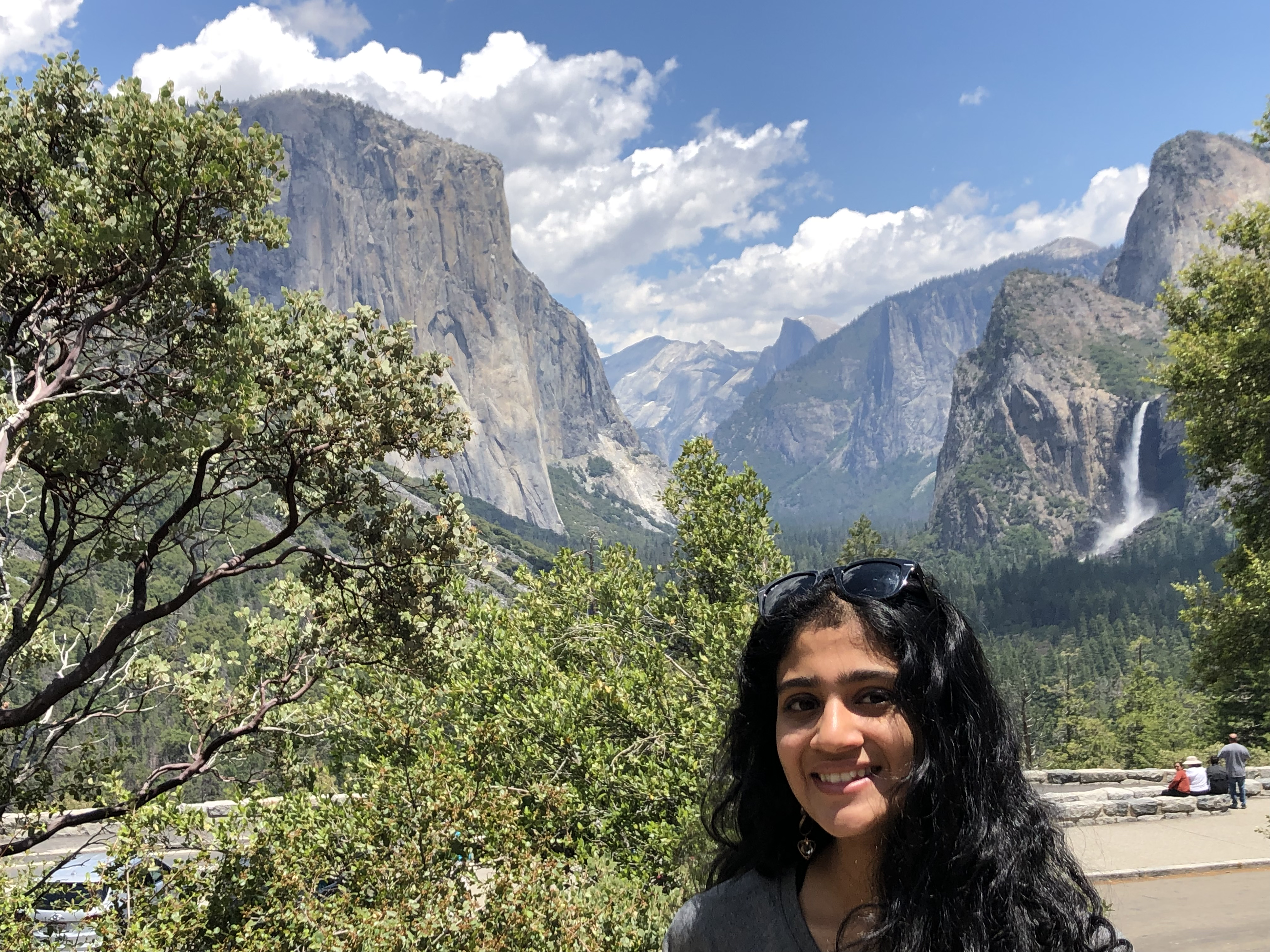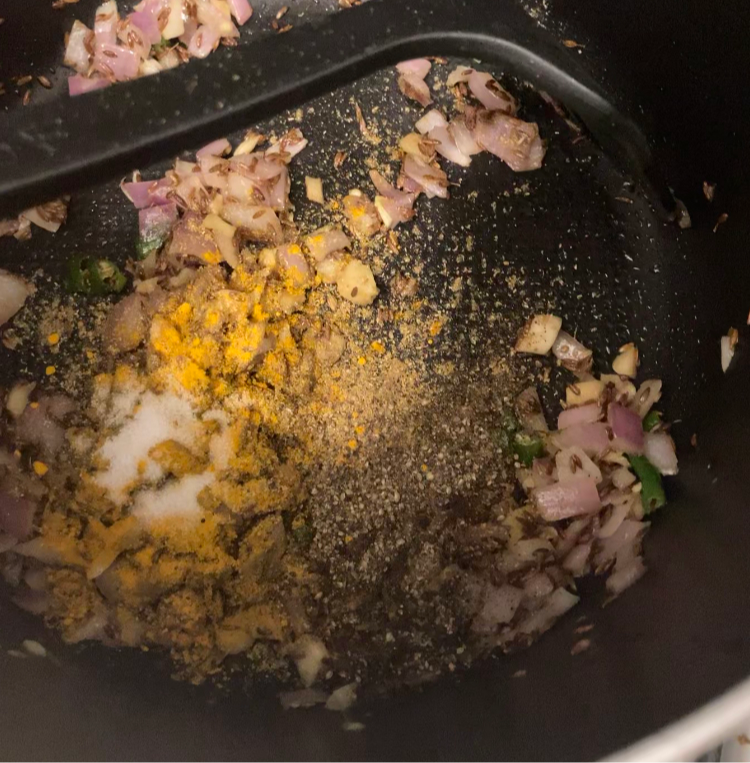Indian cooking made easy
- Aradhana Prabhala

- Dec 25, 2020
- 5 min read
Growing up in an Indian household, I was definitely spoiled. My friends used to tell me my house smelled good, like spices, but I could never smell anything. Even so, I did eat and appreciate the food we made. I never wanted to cook it, though. Watching my parents and grandma cooks was enough- the number of ingredients alone was overwhelming. But when I went off to college, I missed the food. My mom wasn’t going to be around forever, so I decided to get over my mental block and learn.
Surprisingly enough, I discovered that Indian cooking is simple! And now that I’m in college with a limited amount of resources, I’ve managed to come up with a few staples for making a lot of basic Indian dishes. Each dish usually starts off with 2 parts: a base and spices. After that you add your veggies, beans, and meats; and you're good to go.
1. Base
This will form the foundation of your dish whether it’s a curry or dry dish. Most Indian dishes have a simple base of onion, ginger, garlic, green chili, and finely chopped tomato (to make it liquidy) sauteed in oil.
2. Spices
Spices aren’t that scary! Spices can be divided into 2 categories: whole or ground.
Whole:
Bay leaves: they add some bitterness and cut down the richness of many curries! I take them out after cooking, so I like to leave them whole
Curry Leaves: they add this earthy, almost nutty flavor to your dish.
Cinnamon sticks: we tend to use a small amount and they’re usually taken out before serving and we tend to use a small amount. Don’t sub for the powder.
Cumin seeds: they’re essential! (If you don’t have seeds you can use cumin powder, but the powder has a slightly different taste to the seeds)
Mustard seeds: these come in a variety of colors- yellow, black or brown. They add this spicy, pungent, and bitter flavor to your dish and help cut back on the I like using
Cloves: these aren’t as commonly used and have a very strong, mouth-numbing flavor. These are usually used whole and sparingly
Cardamom pods: these have a strong, earthy flavor so be careful not to use too many! You get the flavor from crushing your pods up, and we use both the green shell and the seeds inside
Ground:
Turmeric: this is one of the key ingredients in any Indian dish. It’s got a very earthy flavor, and is also used to color your dish but be careful not to overdo it- a little goes a long way!
Coriander Powder: this is an essential to most North Indian dishes.
Cumin Powder
Red Chili Powder: It has a different taste to green chilies, so I would definitely recommend using it (sparingly) depending on your spice tolerance. I like using Kashmiri red chilli powder because it’s also got this smoky flavor, adds a nice color, and isn’t too spicy so it’s easier to adjust to your spice levels.
Garam Masala: this is a common spice blend found in any Indian store or sometimes in the ethnic section of stores like Whole Foods. Unlike the other spice powders here, garam masala isn’t raw. Various spices are roasted whole then ground together to form a powder. Garam masala comes towards the end of cooking, since it’s already been pre-roasted
3. Techniques
Blooming: adding your spices to a pan with hot oil, and letting it cook for a few minutes, being careful to not let the spices burn. Blooming your spices releases flavor and allows that flavor to be evenly distributed.
Sputtering: It’s similar to blooming but for the cumin and mustard seeds. Once your oil is hot, dump your seeds into the pan and immediately lower to a medium flame to avoid burnt bits. The seeds will make a crackling noise- that’s the sputtering.
Order Matters: it’s what helps create the flavor. Certain spices take less or more time to bloom, and you want the oil to help release all those flavors! First you want to heat the oil, then add your base. Next come your raw powdered spices, then tomatoes, then any pre-roasted spices (like garam masala), then your meats/veggies/beans.
Now that you know the basics, here are a few recipes. There’s one curry, one side dish, and one rice dish for a full meal!
Jeera (Cumin) Rice
This is the rice they usually serve when you go out to eat Indian! You’ll need the following ingredients:
Whole Spices: 1.5-2 teaspoons cumin seeds, 1 bay leaf, a small piece of a cinnamon stick, 4-6 cloves, and 1-2 cardamom pods
1.5 cups of rice
Cook your rice, and don’t forget to rinse it before cooking!
In a pot, add 2 tbsp of oil
Once your oil is hot, add your whole spices and lower the flame to a medium-low

5. Once your spices become fragrant (1-2 minutes) add your rice and salt to taste

You can take out the cardamom pods, bay leaves, cloves, and cinnamon stick after cooking- they've done their job of adding flavor, and getting a mouthful of cardamom or cloves while eating really sucks.
Potato Vepudu (Fried Potato)
This is one of my favorite dishes to make and it’s so easy. You can never go wrong with potatoes! We actually use raw potatoes- it may take a while for your potatoes to cook, but they come out perfect. You’ll need the following ingredients:
1-2 potatoes, peeled and cubed into relatively small pieces
Ground Spices: salt to taste, ¼ teaspoon of both red chilli powder (or to taste) and turmeric powder
Heat around 2 tbsp of oil in a pan on a high flame
Add your potatoes and let them soften, stirring occasionally
Saute when they start turning golden brown
Add the salt and lower to a medium flame. Cover and cook until your potatoes are soft and almost done, stirring occasionally. This should take anywhere from 10-20 minutes
Once the potatoes are almost done, add in your ground spices and turn up your flame to medium-high

6. Saute the potatoes with spices until crispy, about 5-7 minutes. Done!
Rajma Masala
It’s a curry made with kidney beans, and perfect for cold nights! You’ll need the following ingredients:
For the base: 1-2 medium onions, 1-2 cloves of garlic, 4 medium tomatoes, ½ tablespoon of chopped ginger, and 1-4 green chillies (depending on your spice tolerance)
Whole spices: 1.5 tsp cumin seeds
Ground spices: 1 tbsp coriander powder, 1-1.5 tsp garam masala, ½ tsp turmeric powder, and ½ tsp red chilli powder, 1 tsp of salt and black pepper (or to taste)
Wash and rinse 1 can of kidney beans
In a blender, puree the tomatoes until chunky
Chop up the ingredients for your base
Heat up around 2 tablespoons of oil in a medium bottomed pot
Once your oil is hot, add cumin seeds and let it sputter

6. Add your ground spices (minus the garam masala) and saute for about 3 minutes, until the onions turn
translucent.

7. Add your pureed tomatoes and garam masala. Mix well and cook on medium-low heat for about 15
minutes, until you see oil oozing out of your tomato mix

8. Add your kidney beans and some water (I start with around 1 cup and then add more if I want it less
thick)

9. Let it all cook for 20-30 minutes. Garnish with some lemon juice and chopped cilantro (optional) and
you're done!
As it turns out, Indian cooking isn’t as complicated as it looks. Once you figure out the key ingredients and the order in which to cook them, the rest is pretty simple. With the basics down, you could make a whole meal!

Indian cooking is also really intuitive and doesn’t really depend on measurements- I learned from observing my family members cook. It’s all about trial and error- once you get comfortable with the various ingredients, you’ll find that you won’t really need any measurements, you’ll just know. At least, that's what happened to me. Happy cooking!






Comments